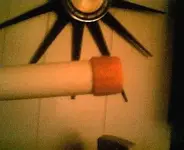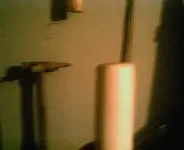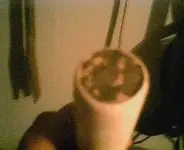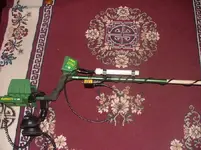Re: Sunray probe for GTI 2500?
I Finally got the Sunray probe out for an initial test run yesterday afternoon. I went to the local middle school where I know there is apt to be some clad at different depths to test it on. In all fairness, this was by no means a really good test or wringing out so to speak. It was just a sure fire easy target acquisition site.
My first target came ringing in on my GTI 2500 as a dime sized coin at one inch deep. After pinpointing with the detector using the standard coil, I switched on the Sunray unit and located the coin with it to confirm my pinpoint accuracy with the 2500. Both signals coinsided so I used the point of my Gator tool to pop the dime out from under a grass root. So what does that tell me? It proves that the Sunray unit is at least as accurate in locating a shallow target as the coil on my 2500. But, it is no more accurate on this one shallow target than my $39.00 Automax II.
My next target was showing a coin sized object at 2" deep. The signal was bouncing between the nickel and pull tab icons on my 2500's display. After pinpointing with the detector itself, I dismounted the Sunray probe, switched it on and proceeded to relocate the target with the probe. Again the location of the target was the same, but slightly smaller in estimated area than with the detector's pinpoint. The indicator on the detector's LCD display settled on the nickel icon with the probe, depth at 2". I dug down two inches and didn't see the coin, so I checked the hole with the Sunray probe and not finding a signal, moved it to one side where I located a nickel entangled in the roots of some Bermuda grass. The coin was more shallow than either unit indicated, but I was able to find the coin already dug out of the hole when I used the Sunray probe. Again, nothing I couldn't have done with the much less expensive Automax II probe.
I forgot to switch the probe off and was receiving a really loud steady tone screaming over my earphones. It took just a second to figure out what I had failed to do. If you forget and leave the probe turned on, it lets you know right quick!
Now is a good time to explain how the Sunray unit is mounted on the detector. I mounted the box or brains of the unit under the shaft on my detector by using a supplied plastic or nylon clip and a bolt that goes through the adjustment holes on the shaft. It is out of the way but easy to reach with one hand when needing to switch the unit on by means of a small toggle switch. The diminutive size of the toggle switch makes me wonder how sturdy it will be under constant use? The probe itself is held onto the top of the shaft of the detector by two plastic tension clips, secured with nylon or plastic bolts through the expansion holes in the detector's shaft. It should be mentioned that the clips have very sharp corners and if you aren't paying attention to what you're doing it can cause a nasty cut on your fingers! I think I will take a file and round off the corners on mine as it did "bite" me a couple of times. The probe is otherwise sturdily mounted but easily dismounted and remounted by pulling it out of the clips. There is a sufficient length of electrical cable to reach your dig area with the detector itself laid on the ground beside the hole. It is a little awkward to use the probe and view the LCD screen at the same time however. The weight of the Sunray unit doesn't seem to be noticeable nor does it upset the balance of my GTI 2500 when in use. So on with the test run.
The next target was a coin sized item at 4" indicated by the detector, bouncing between the nickel and pull tab icon. I pinpointed the target with the detector but was unable to locate it with the probe! I dug an approximate 2" deep plug and reinserted the Sunray probe into the hole. This time I did get a similar target signal with the probe, but still showing it to be another 4" deeper. I dug down another two inches and didn't see a target so once again, in went the probe.....which was still showing a target at 4" deeper! After another dig of two inches, six inches total, I quit the dig, the probe still showing a target at 4". In checking around the plug and hole with the probe, I found half a pull tab in the lose dirt. Apparently I had dug out the original target and somehow missed it with the probe. I am guessing the probe was signaling a larger target even deeper, possibly ferrous in nature? (The Halo Effect)? I had the detector's program set to discriminate ferrous or iron targets. This situation was puzzling as the Sunray probe should have had the same amount of discrimination as the detector itself. Since I didn't continue to dig beyond 6", I don't know what the secondary target was or if there was a legitimate secondary target. The detector was originally giving off a nickel/pulltab tone while the probe was sounding a much softer tone. More than likely I can chalk this one up to operator error? Until I think about it some more, I just don't know.
After that one puzzler I dug up several clad pennies at 4" or less, the probe being accurate in backing up what the detector coil was indicating, although better narrowing the exact location of the coins in most cases. The probe did reach down a full four inches to pick up the deeper pennies. The Automax II pinpointer will only reach a depth of about one to one and a half inches at best. With the detector itself all the clad pennies were bouncing between a penny and a dime on the LCD display. With the probe they tended to steady at either a dime or a penny. From experience I knew the target wasn't a dime because of the absence of the bell tone signal. On my particular GTI 2500 a dime is very distinct, giving off a very loud bell tone as opposed to the penny signal that will emit a soft bell tone one way and a usually a definite penny signal the other way as the coil passes over it. My first target was a dime and there was no mistaking it for a penny.
So, that was my very first real test for the Sunray probe. When I got home and cleaned up the pennies I found I had recovered a 1951 wheat cent somewhere and that was confusing.....except I remembered I had dug up a wheat cent on another site and it was still in my pouch! I wish I had dug up the wheat cent on this outing just to see what signals it gave off compared to the clad pennies and the dime.
Due to poor vision, I find a pinpointer a necessity for me to TH without wasting a lot of time looking for a target that has already been unearthed. The Sunray probe is definitely a time saver in that respect. For those of you that have trouble pinpointing, it should prove a Godsend for shallow targets, especially for those in the two to four inch depths. (I am speaking of coins only as I have not tested it on other targets). For coin targets very near the surface I don't think it is any better than any one of the other much less expensive pinpointers on the market. The only advantage I see for very shallow targets is it's accessability, being there on the detector itself. You don't have to carry around an additional tool to probe or pinpoint.
In reading this evaluation you must remember it's based on only one outing with very liberal controls and interpretation, and is just my initial impression of the Sunray probe. As I test it further and gain more experience I may find additional advantages or disadvantages to its use. I reserve the right to change my mind based on these considerations. Monty







